-
Posts
2,406 -
Joined
-
Last visited
Content Type
Profiles
Forums
Gallery
Events
Articles
Posts posted by Ian
-
-
I missed out on this thread first time round. Yet another area I never even knew existed, at least not to this extent! absolutely fascinating.
I never cease to be impressed by your sleuthing abilities Mr Constanius. i define intelligence in terms of knowing how to find what you need to know. You certainly manage to dig out the detail.
Nice items you have there Clive. I'm even a wee bit envious........... nice finds indeed.

-
Looks to me like someone has used a mechanical device for cleaning this item. Actually, that is an understatement. Possibly either sandpaper or steel wool has been used. You couldn't get the surfaces much courser short of taking a bl**dy chisel to it!
Upshot is that It's still the best example of this jeton that i've seen to date, and it was (relatively) cheap......but no prize to the previous owner for their conservation skills. They must have been given a Dremel for Christmas and thinks that the only good coin is a shiny one.
-
I only discovered the existence of this particular jeton a month or so ago.
Issued during the time of Napoleon III for Le Triton, a maritime assurer circa 1860.
This jeton is unusual as it is very 3 dimensional in terms of the bust of Nap III. Unfortunately it also appears to have been harshly cleaned by someone with aversion to toning, so sun glasses are a requirement for viewing. Ah well rarity never comes cheap unless there is a downside.......

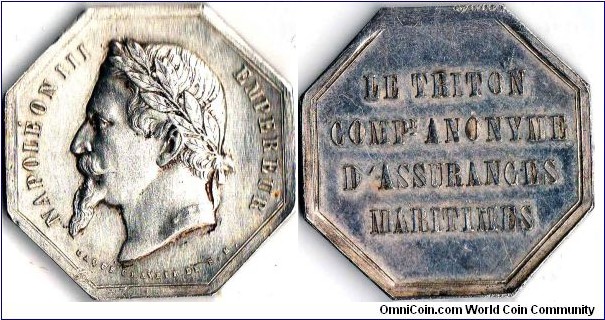
-
This jeton was struck for Jean Antoine de Mesmes, the then President of the Court of Justice, in 1713.
The reverse of this jeton normally appears in combination with the bust of the king of France and issued for the Court Prosecutors. This one however was specific to De Mesmes with his coat of arms obverse. It would have been one of a number of silver jetons presented to him in a purse as payment for his service in office for that year.
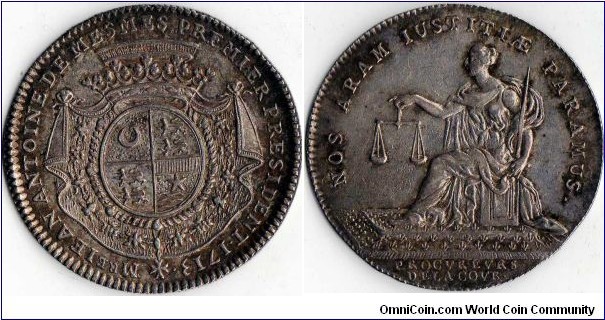
-
I like the top one but that might just be the toning or photography, it seems to give a bit more depth.
One has fruit on the ground, the other doesnt.
The baskets have different design.
One has 6 rows of apples in the basket, the other 7?
Different borders
Period after A in one and not the other?
Both very nice tokens.
The top one is my favourite too...
The bottom one has a crisper strike and less wear to it, but for me it lacks `character' (for want of a better word!). i think the toning adds some definition to the subject matter.
PS in the first example the angle of the boxed tree in relation to the exergue line is more pronounced

-
The Chateau de Sceaux is a great place to visit when it's nice out --beautiful gardens and extensive fountains. Big enough that you could read a book on the lawn without being found out and scolded by one of the groundskeepers.
 The Orangerie (a building) is still there but closed to visitors .
The Orangerie (a building) is still there but closed to visitors .you are a much traveled man Frank. I am quite envious of your in-life experience. I've yet to visit that location, and suspect that short of a substantial lottery win i'm unlikely to be reading a book on the front lawn any time soon

-
I thought I should explain my reasons for my comment quoted above. (snip)
I don't think that F would have just plucked The Horticultural Society of Rouen from a hat, he must have some evidence or reason for ascribing these jetons to it. Perhaps it was an error but it would be nice to have some concrete reason or evidence for that.
I have to say that i agree with you. However I've spent only a limited amount of time to date in researching these and as yet I have been unable to ascertain why both Mitchiner and CGB both feel that Feuardent was wrong in assuming the reverse to be oranges. I'm less than convinced, although i did come across one article describing `aurea poma' as being a variety of apple. Never followed up on that.
On the other hand i've been equally unable to find anything that would validate Feuardent having associated these jetons with the `Horticulturists of Rouen' (as opposed to the Horticulturists of somewhere else).
I've got a healthy respect for CGB's relative breadth and depth of knowledge of `jetons'. I will however be asking Michel Prieur at CGB for some insight and hopefully some source reference for their belief that Feuardents classification is no longer sustainable.
-
There is some debate as to who the following (undated) jetons were issued for / by.
Feuardent, the main reference source for french jetons cites the Horticulteurs de Rouen and goes on to assert that they may have been struck for the Orangerie at one or other of the Royal Chateaux near Paris (citing Versailles or Chateau de Sceaux as possibilites). `Hortus Hesperidum' (Garden of Hesperides) appears in the exergue obverse, while the reverse legend is Cultori Aurea Poma (Golden apple cultivation).
Both CGB and Mitchiner state that although Feuardent was correct in thinking the trees are orange trees (obverse), he was incorrect in thinking that the fruit in the basket (reverse) was oranges. Although `aurea poma' is easily construed as being oranges, it is also the name of a type of apple (some mention is made that the type is used in cider making. Mitchiner notes that the modern view is that the jetons most probably relate to the Paris Fruit Merchants and that there is no relevance to the town of Rouen.
Both jetons are quite similar but clearly from different dies. I'm reminded of newspaper type puzzles showing two similar pictures and asking you to `spot the differences' . With that in mind, i'll leave you to see how many differences you can spot. Sorry, no prizes in this case folks!

In terms of dates for these....generally perceived to be early republic /Napoleonic era (circa 1792-1806)
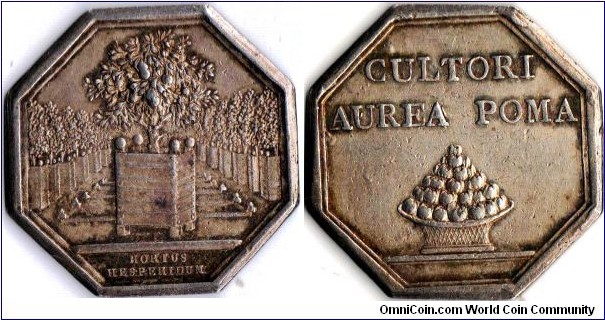
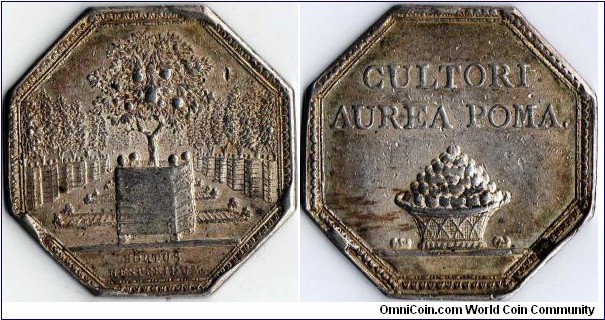
-
I maintain similar displays for all my gold medals.
(That should provide one clue to the number of gold medals in my collection.)

-
Art!!
I like both of these. What would it take to tempt you to part with an example of each?
-
You should be endowed with the title of `Honourary Scot' for that particular purchase.
Another excellent addition to your growing collection. Well done!
Ian
-
Nice examples you have.
The standard reference for royal jetons is Feuardent, although modern dealer / auction catalogues tend to reference more variants than are noted in Feuardent. As such it is a starting point for research, but by no means the `one stop shop' for referencing.
I'll check out Feuardent and my CGB catalogues when I get the chance and get back to you.
I suspect you have more jetons in your collection than the ones shown here.
Feel free to post images of them. I'm well and truly `hooked' on collecting these little history encapsulating metal discs!
-
no problem friend. Just wasn't getting the `porn' bit. Must be because i'm a dour Scot.
......It's taken me long enough to get used to coin buffs referring to images of coins as being `eye candy'. my idea of eye candy is something entirely different

-
seriously, i'm not seeing what you must be seeing. care to elaborate?
-
you must be seeing something that i'm not........
-
here's the earlier example of the jeton I mentioned. It's actually in a wee bit better condition than the scan would have you believe, but not exactly a pristine example. :
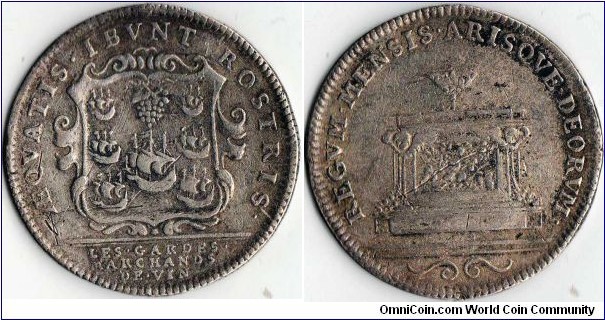
-
Here's a scarcer jeton issued for the Languedoc Parliament in 1733 (again with the croix de Toulouse in the exergue). The obverse legend alludes to the young Louis XV following in the footsteps (and greatness) of his predecessor, Louis XIV. The reverse shows the equestrian statue of Louis XIV which was erected in La Place du Peyrou, Montpellier in 1718.
In 1732 the Languedoc Parliament took the view that La Place du Peyrou was too down market for such a glorious work of art and commissioned the agrandisement of both the statue's plynth and its locale. The Languedoc Parliament took the decision to make the 1733 issue of jetons commemorate the commisioning of the work, .........which by the by took a further forty years to complete.
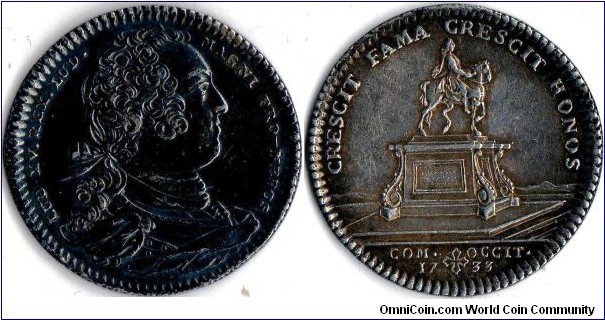
-
People with big powerful hands always found it easy to get a job at `La Medaille'. To become a monayer you had to be able to both hold, and screw the dies tightly together. I'm just amazed at how they managed to avoid serious burns given the heat that must have been generated in the process. Sometimes, for really special pieces, they also gave the dies a quick whack with a 25lb hammer. If the monayer wasn't fast enough he'd find that it was his hand being struck and not the dies. On such an occasion the shock waves would transmit through the hand, crack the die, and show evidence of the event on the jeton being created.
Think about it. it's the only reasonable explanation for a die crack being evidenced on a jeton which has been struck that way..........

-
True. A die in its death throws, and (a bit on the dramatic side), it looks a bit like St Jaques is being struck by lightning

-
The first record of this type appeared as a mention in `Le Mercure' the magazine of the Paris Mint for 1683. It descibes the legends using `V' whereas the one in this thread shows the more modern `U', which in turn determines this one as a later issue under Louis XV. My guesstimate for the strike is 1730- 1733 (ish)
The other one i have in my collection uses the `V' and has the coat of arms in a square cartouche which is in keeping with the one described for 1683. However, i suspect the jeton was not actually issued until the 1690's.
There is a short series of jetons issued between 1651 and 1691 for the `Confrairie des Marchands de Vin'.
Mitchiner states `The Marchands de Vins (Wine Merchants) spent a century pleading for admission as a `Seventh Company' and adopted an appropriate coat of arms.'
The Drapers actually obtained their ranking by purchase from the Furriers (Les Pelletiers) who were subsequently reduced to fourth ranking within the sixieme Corps. As an aside there are no jetons recorded for the Quatrieme Corps.
-
Not much more info available for this jeton, but see following:
-
Thanks. there is a variant to this particular jeton which i've also got somewhere in my collection. I'll dig it out and scan it when next I get the time (and notion)
I've got lots of different jetons relating to the various merchant guilds of Paris and associations along with jetons issued on behalf of the various `Prevots des Marchands' (Lord Provosts of Paris aka `Mayors' who were basically elected from the ranks of the merchant guilds) and other locations most of which i simply haven't got round to scanning. i usually only bother with new additions to my collection.
I know that you have more than just a passing interest in jetons Frank, having owned a few yourself in the past. If there is any area you have an interest in i'd be more than happy to look at my collection to see what i have relating to it and post them on this forum.
-
This is a silver jeton issued by the `septieme corps des marchands' as the wine makers guild liked to be known. IThe six main guilds(Les Six Corps des Marchands) were not so keen on sharing their power and influence.
The Premier Corps (Drapers guild) issued jetons with one ship in the shield. The Deuxieme Corps (Apothecaries) issued jetons with two ships in the shield.......etc. Hence the `Septieme Corps' having seven ships in the shield.
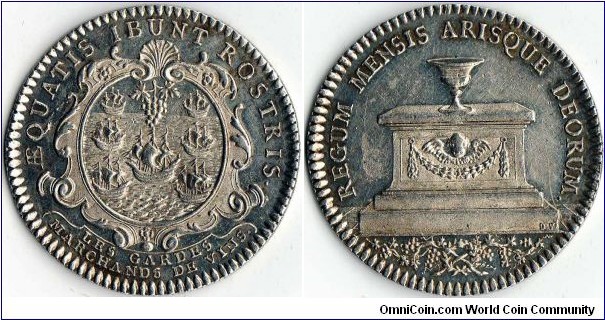
-
This jeton was issued in 1645 for the Burgundian Parliament which sat at Dijon, the main town in the region. It was struck shortly after the death of Louis XIII (1643) at which time the young Louis XIV was all of five years old. His mother, Anne acted as Regent, but the real work of the state was entrusted by her to Mazarin.
No doubt this jeton was issued to re-inforce the succession and authority of the regency in the name of the king.
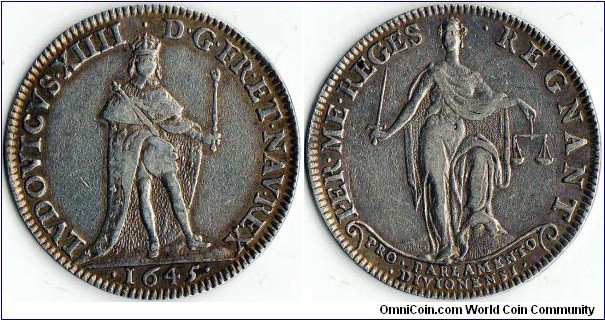


Royal School of Surgery, Paris
in Exonumia (Tokens, Medals, etc) Forums
Posted
Three different busts of Louis XVI , two different reverse dies. All dated 1775.
The first shows a mature bust Louis XVI obverse with the original building for the School of Surgery reverse
The second shows a mature bust of Louis XVI obverse but with different legend, with the School of Surgery and its extensions reverse
The third shows a youthful bust of Louis XVI and same reverse as the second.